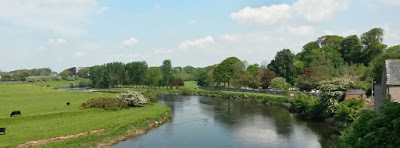Note: Contains spoilers for Bridgerton, Season 3.
I recently awoke on a Saturday faced with the delightful prospect of a day without obligations. The sun was shining, the birds were singing, and the morning air was cool and pleasant. It was a storybook beginning.
I rolled out of bed, pulled on my dressing gown, and imagined myself as a lady of leisure. I took it a step further and imagined myself in the world of Bridgerton – or at least as close as I could get in America of 2024.

I proceeded downstairs to the kitchen and poured myself a cup of fresh coffee. The coffee was ready and waiting, prepared not by a servant, but by my conveniently programmable coffeemaker. Outside, I sat in the garden while my dog lolled on the grass. I listened to the birds. I fussed over a container of bright yellow pansies (pansies are everywhere on Bridgerton) and admired the hydrangeas about to bloom.
A little later, I dropped off a jar of homemade strawberry preserves at my neighbors’ house, a small token of appreciation for a favor they’d done me. I walked in the streets of my respectable but not fashionable neighborhood, admiring the well-tended yards and lamenting those that were not. I attended to a few household matters and attempted some writing – longhand, in cursive – including the draft of this blog post.
In the afternoon, I called at a local dress shop. This activity felt remarkably Bridgerton-esque: I traveled to the shop on foot, met a friend there whose advice I’d enlisted to guide my choice (I was shopping for a wedding dress), and needed the assistance of the salesclerk to get myself in and out of the gowns. At one point, the salesclerk had to buckle my shoe for me: I was literally standing on a pedestal, immobilized by yards of crepe and Italian tulle. The amount of fuss unsettled me, as did being unable to do even the simplest activities on my own. Still, part of it felt fun – when else had I received such attention? Or reveled in simply searching for what would make me feel beautiful?
For say what you will about Bridgerton, it is beautiful. The homes, the clothes, the gardens, the characters. Rarely do you see poverty, disease, or work of any kind (aside from the servants, and even then, their chores are apparently mostly carrying trays and arranging hair and fetching the occasional snuffbox.) The Bridgerton ladies themselves rarely engage in any activity more demanding than taking a constitutional or ringing for tea. Dancing, I suppose, may be an exception, and there are the few ladies who ride.
I managed to practice my French. I neglected my music (in my case, an electric guitar, which is decidedly anachronistic), but did decide to take advantage of the fine weather for some exercise. I went on a late afternoon ride, by bicycle, through very pretty woods and afterwards, enjoyed an indecorous pint of ale. Unchaperoned.
I thought of what the show gets right about the Regency era. Or at least, doesn’t overly distort or misrepresent: the strict social rules, aristocratic privilege, the pressure on women to marry, the vast disparity between genders in what was sexually acceptable.
Yet there is much that is fantasy. The racial equality among the ton and portrayal of Queen Charlotte as a black woman are two plot points on the show of deeply questionable accuracy. And as much as I would have liked for the romance between Brimsley and Reynolds, as well as other same-sex pairings, to be able to flourish in the early 1800s, in reality they would have been subject to sodomy laws that would have considered their intimacy a capital offense.
Heterosexual relationships also came with real risks, particularly for women. Women had no lawful political power, no voting rights, no ownership rights to property once they married. The second her wedding ceremony concluded, Penelope would have forfeited every penny of her earnings as Lady Whistledown to Colin Bridgerton. Her children, too, would be considered her husband’s property (this was not settled until decades later, through the remarkable case of Caroline Norton). The show does not address the fact that Penelope would stand to lose a lot more than the power of her pen once she became Mrs. Bridgerton.
Of course the era did have many brilliant women: Jane Austen, Mary Wollstonecraft, Mary Shelley, and others. This was also the period of Byron and Keats and incredible exploration and scientific discovery. It was likewise a time when syphilis could be a death sentence, half of the female population was illiterate, and it was considered acceptable for a six-year-old to work a 10-hour factory shift. Don’t even ask about maternal and infant mortality.
I look at Bridgerton as a cautionary tale as much as it is an escape. It is a reminder to beware of making over the past in our own image. To pause before rushing to snap up show-themed merch without any understanding of what it is we want to imitate. To proceed carefully so as not to forget the truth of history. Amnesia may be convenient, but it is no cure.
Producer Shonda Rhime’s Mayfair is sparkly and entertaining and shamelessly sanitized. It could be a fun place to visit, but no one actually lives there.













